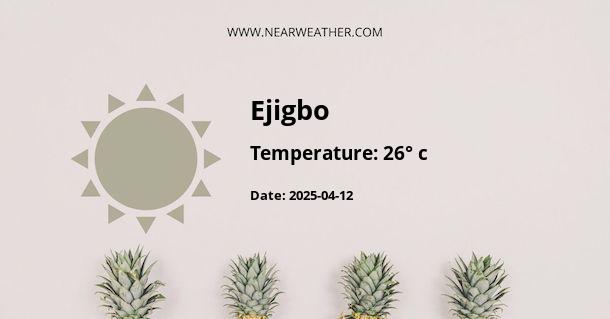Ejigbo, Nigeria: Climate and Weather Year Round
Ejigbo is a vibrant town located in the Osun State of Nigeria, known for its rich cultural heritage and historical significance. Understanding the climate and weather patterns of Ejigbo is essential for both residents and visitors to plan their activities and make the most of their time in this beautiful location.
Geographical Location
Ejigbo is situated in southwestern Nigeria, close to the equator, which influences its overall climate. The town is located at a latitude of 7.9°N and a longitude of 4.32°E. Its proximity to the Atlantic Ocean also plays a role in the weather patterns experienced throughout the year.
Overall Climate
Ejigbo experiences a tropical savanna climate, characterized by distinct dry and wet seasons. The town is located within the sub-Saharan region, which is known for its hot and humid weather conditions. The climate is influenced by the West African Monsoon system, which brings alternating periods of rainfall and dry spells.
Temperature
The annual average temperature in Ejigbo ranges from 25°C (77°F) to 32°C (89.6°F). The hottest months are typically between January and March, with temperatures often exceeding 35°C (95°F) during the day. The coolest months are between November and February, with temperatures dropping to around 20°C (68°F) at night.
Rainfall
Ejigbo experiences a distinct wet and dry season. The wet season typically begins in April and lasts until October, with peak rainfall occurring between June and September. The annual average rainfall in Ejigbo is approximately 1,500mm (59 inches). During the wet season, heavy downpours and thunderstorms are common, occasionally leading to flooding in low-lying areas.
On the other hand, the dry season spans from November to March, with very little rainfall. December and January are usually the driest months, with less than 10mm (0.4 inches) of precipitation on average. The dry season is characterized by sunny and warm days, providing ideal conditions for outdoor activities.
Climate Variations
Although Ejigbo has a relatively consistent climate, there are some variations in weather patterns throughout the year. These variations can be attributed to factors such as the Harmattan winds, local topography, and oceanic influences.
Harmattan Season
Between November and February, Ejigbo experiences the Harmattan season, which is characterized by the influx of dry and dusty winds from the Sahara Desert. These winds can significantly reduce visibility and lead to a drop in temperature. The Harmattan season also brings with it dry air, which can cause skin dryness and respiratory issues.
Coastal Influence
Ejigbo's proximity to the Atlantic Ocean plays a role in its climate variations. The coastal areas in the southwestern region of Nigeria experience higher humidity levels compared to inland areas. This coastal influence contributes to increased moisture content in the air, especially during the wet season.
Weather Highlights by Month
Here is a monthly breakdown of the weather highlights in Ejigbo:
| Month | Average Temperature (°C) | Average Rainfall (mm) |
|---|---|---|
| January | 28 | 3 |
| February | 30 | 6 |
| March | 31 | 16 |
| April | 32 | 94 |
| May | 32 | 140 |
| June | 30 | 205 |
| July | 29 | 200 |
| August | 27 | 250 |
| September | 27 | 240 |
| October | 28 | 131 |
| November | 28 | 19 |
| December | 27 | 6 |
These monthly averages provide a general overview of the weather conditions in Ejigbo throughout the year. It is important to note that actual weather conditions may vary.
What to Pack and When to Visit
When planning a visit to Ejigbo, it is essential to consider the climate and pack accordingly. Here are some recommendations:
Wet Season (April - October): Pack lightweight and breathable clothing, including rain gear and waterproof shoes. It is also advisable to carry insect repellent to protect against mosquitoes.
Dry Season (November - March): Choose lightweight and loose-fitting clothing to stay cool during the day. However, evenings can be cooler, so it is recommended to bring a light jacket or sweater.
Harmattan Season (November - February): Prepare for cooler temperatures and dry conditions. Pack warm clothing, including long-sleeved shirts, pants, and a scarf to protect against the dusty winds.
The best time to visit Ejigbo is during the dry season, particularly between November and February, when the weather is generally pleasant and outdoor activities can be enjoyed without interruption. However, if you are interested in experiencing the cultural festivals and events in Ejigbo, the wet season can also be a great time to visit.
Conclusion
Ejigbo, Nigeria, has a tropical savanna climate with distinct wet and dry seasons. The town experiences hot and humid conditions throughout the year, with the wet season bringing heavy rainfall and the dry season offering sunny and warm days. Visitors to Ejigbo should consider the climate variations, including the Harmattan season and coastal influences, when planning their visit and packing their bags. With this knowledge, residents and visitors can make the most of their time in Ejigbo, enjoying its vibrant culture and historical significance.
A - Ejigbo's Latitude is 7.900000 & Longitude is 4.316670.
A - Weather in Ejigbo is 26° today.
A - Climate Conditions in Ejigbo shows overcast clouds today.
A - Humidity in Ejigbo is 75% today.
A - Wind speed in Ejigbo is 15.26 km/h, flowing at 199° wind direction. today.
